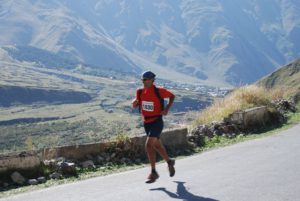Heavy athletes tend to hate running. It takes its toll on the joints and tends to feel like hell to complete. It is not comfortable and it certainly isn’t enjoyable for most. Recently I read 80/20 by Matt Fitzgerald. It focuses on using low intensity running for the base of a runner’s training. The concept is not new but is firmly supported in scientific literature and anecdotal evidence. It made me wonder if its concepts would apply for larger, non-runner athletes. I had seen similar concepts being used elsewhere for large powerlifters but had never really considered it a practical option beforehand. I tried it and can definitely say it worked amazingly well for improving overall fitness.
Humans by nature are task oriented individuals. We tend to want a result or some measure of how we complete a task. For running this generally revolves around a distance quantified by time. This is the mistake for many non-runners. If you are heavy you will more than likely be slow, in many cases embarrassingly slow. This can be the root of distaste for running. The thing to bear in mind is that absolute aerobic ability is often better in a larger athlete than a smaller one. They are not unfit or untrained, just hauling more load around. This means they will run slow even though they may actually be aerobically well trained. Take a prop forward for example. 130kg is a lot to move around for 80 mins and requires a massive aerobic engine. This does not get reflected once normalized to bodymass. If one can accept this then one can forget about how well or how fast they run, and focus on what matters, what they are running for.
Low intensity aerobic work is great for a number of things. In general it creates a number of extremely beneficial structural adaptations. Most of these relate to remodeling of the heart and vascular system but there are a number of other responses. In addition, low intensity work can improve fat metabolization and overall body composition, things which are nearly always concerns in a heavier athlete’s life. These are all positive but not the main points of the article. In addition it should be noted there are some aspects of low intensity work that are considered negative influences on power type sports. This was discussed in a previous article which can be found here https://hamiltonsport.com/2016/12/will-cardiovascular-training-kill-strength/. To summarize very briefly, low intensity work very rarely makes anyone slow if used appropriately.
Low intensity running in this case is running which is restricted by some measure of effort rather than speed. Heart rate or Rate of Perceived Exertion (RPE) both work well. Heart rate should be around the 70% of heart rate max point or an RPE about five out of ten. The speed is dictated by this, not the other way around. If these increase then slow down to a shuffle or walk if necessary.
So what makes low intensity running so wonderful? Firstly, aerobic conditioning always provides an excellent base for all athletes. Running is something which uses a large amount of muscle mass and definitely produces beneficial adaptations to aerobic capacity. Perhaps one overlooked aspect is the ability for it to teach an athlete to relax on their feet. By forcing yourself to run slower to meet heart rate one eventually learns to be more efficient with technique. While on a run the individual should focus on playing with style and stride to keep heart rate down. After a while one will learn to relax the upper body and breath nice and steadily so as to not waste effort. With some practice the ability to relax and settle into a run can be a very useful tool. It effectively allows an athlete to learn to recover while on the move, something which can drastically improve overall work capacity throughout competition.
Running slow and relaxed also saves the joints. When one becomes more efficient and fluid with style the wear and tear on joints is reduced. This will partly become a result of better technique from practice but slowing oneself down also reduces impact. By focusing on low intensity, one generally feels like things are less of a struggle and more enjoyable, making it more likely to repeat the session. Recovery from the session is also improved for the above reasons. The day after, aches and pains are very much reduced.
It should be noted that little of the above happens overnight. It will take weeks to become relaxed and efficient. The point is that limiting the session by factors other than speed makes the training more manageable, enjoyable and overall more effective. After some time, the interesting thing is athletes will run faster and faster without breaking the intensity limits. This happens quicker than many expect and after a while those who hate running can become quite good and really begin to enjoy it.

A lot of the above seems obvious. If one gets better and fitter at running one will be faster and enjoy it. There is no rocket science there. The point is if one shifts the focus it can really foster the training effect without creating issues that so many athletes experience when running. The slightest change in perspective can make a massive difference to the process. Heavy athletes are more susceptible to experiencing issues with running but the process should remain the same for all. There is a right way and a less effective way to approach things, in some cases a completely wrong way. In this case if running has never been something you or your athlete has used or enjoyed try shifting the approach and give low intensity running a try. With a bit of patience and diligence the benefits can be quite astonishing.
If you enjoyed this then please like and share!
[yikes-mailchimp form=”1″]
